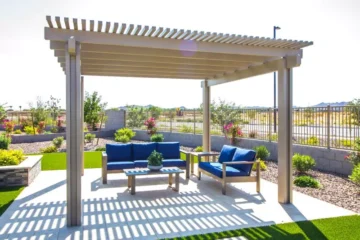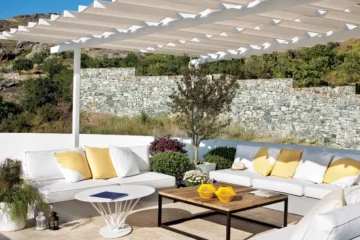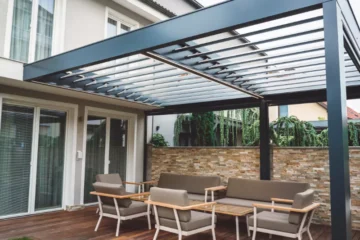Table of Contents
With spring on the horizon, I find my mind drifting more and more to all the projects I want to undertake this year. One project, in particular, is adding a pergola to my patio. As such, I thought I’d write a post covering the basics, like “What is a pergola?” and “How are they different from gazebos?” I’ve included all the information you need to know and why you might want one in your yard too.
What is a Pergola?
A pergola is a structure consisting of four posts and a roof of uncovered rafters and cross beams. They’re most often constructed from wood, vinyl, or metal. The point of a pergola can be different for every yard. For example, some people use them for shade or privacy by adding screens. They can help block some of the UV while still allowing enough draft to keep an area from becoming stuffy. They can also help keep out bugs like mosquitos or nosy neighbors. Some people also just like them for their aesthetic value. They’re useful for hanging string lights or even growing vibrant flowering vines.
What’s the Difference Between a Pergola and a Gazebo?
Now that we’ve answered “what is a pergola,” you might be wondering what makes it different from a gazebo. What about a pavilion? These are all similar outdoor structures. The biggest difference between a pergola and a gazebo or a pavilion is the roof. While pergolas have an open roof, gazebos and pavilions are covered. Gazebos are often a different shape than pergolas too. For example, pergolas are rectangular while gazebos tend to be more round or hexagonal. Some gazebos also have a built-in floor or railing around the sides. This makes them a good option for DIY bars.
What’s the Difference Between Traditional Pergolas vs. Louvered?
Traditional pergolas have fixed beams, which provide limited shade and weather protection. This can be remedied, of course, by adding a screen to the top or adding vines to create a natural cover. Both of these options will work, but their drawbacks could be a deal breaker for some. For example, many vines are easy to grow and spread quickly. But they won’t limit themselves to just your pergola. If they’re close to your house or some other structure you may not want them on, maintaining them can become a chore.
If you choose to buy a standard screen instead, you’ll have to manually move it if you want more or less shade. For this reason, some people choose to buy a louvered roof. Louvered roofs have moveable slats rather than fixed. They open and close with a lever or a remote, making them easier to adjust than a screen.
What is A Pergola’s Lifespan?
The longevity of a pergola depends on a few factors. The first is what type of material you choose. Three of the most common types are aluminum, vinyl, and wood.
Wood

Many traditional pergolas are wood. They have a nice and natural look that can make them more appealing than other options. As far as weather and pest resistance go, however, wood is the least resilient material against pests and weather. As such, out of the three materials, it will tend to have the shortest lifespan. But some species can last much longer than others. For example, Western Red Cedar or Acacia are great choices. If maintained, wood pergolas can last around a decade or longer.
Aluminum

In general, an aluminum pergola will last much longer than wood. Some estimates say around 20 years or more, while others claim a lifetime. They won’t rust and need little maintenance above cleaning or an occasional touch-up on paint. One downside to aluminum is it’s a lightweight material. This means it may dent more easily than other metals and needs to be well anchored. This is especially true if you live in an area that gets high wind regularly.
Being a metal, it may also heat up and become too hot to touch, depending on the pretreatment. As opposed to wood, most aluminum pergolas have a more modern look. But there are some sellers out there who offer aluminum pergolas that look like wood.
Vinyl

Like aluminum, vinyl will last a long time (decades) and require less maintenance than wood. But they’re even more lightweight than aluminum. They also tend to offer fewer options for customization and tend to look more formal.
How Much Does a Pergola Cost?
If you want to cover your entire patio or another large area, aluminum or vinyl will likely cost you the most. If you purchase one online, the average price range for a 12×16 ft vinyl pergola is around $1,800 to $4,000. However, some are as much as $10,000 or more. The average for an aluminum pergola of the same size is $3500 to $5000, compared to high hundreds to around $3,000 for wood.
Whether the roof is static or louvered also plays a big role in the price. Louvered roofs can raise the price by several hundred to a few thousand dollars more. The type of wood also affects the price, with cedar being the more expensive option.
How to Add a Pergola to Your Backyard?
To build or to buy, that is the question. If you’re building, you might find wood the be the easiest option to work with. Many people are more familiar with wood. It will probably be easier to source as well and to customize. Building your own wood pergola is also going to be the cheapest option if you have a low budget. If you’ve settled on buying one, there are plenty of kits online for any of the three materials. Another option is to have a local builder construct one for you.
Conclusion
What is a pergola? Pergolas are outdoor structures that have both aesthetic and practical value. They can be decorated with flowering vines or string lights. Or to create shade or privacy. They differ from other structures such as gazebos and pavilions, in that they have an open roof, which can be either fixed or louvered.
Pergolas can be made from several different materials, each of which has pros and cons. Three of the most common materials are wood, vinyl, and aluminum. If you’re building your own pergola, wood is often the cheapest and easiest to work with. But it also has a shorter lifespan and requires more maintenance. Aluminum is the most expensive, but it has a much longer lifespan than wood and less maintenance. It also offers more customization than vinyl.
Adding a pergola? Check out these design ideas.





0 Comments